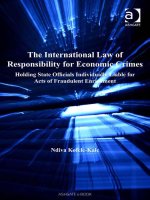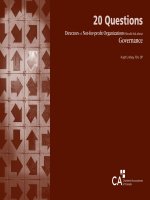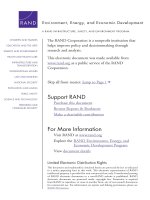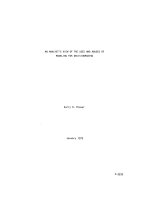Fuzzy-based quantification of congestion for traffic control
Bạn đang xem bản rút gọn của tài liệu. Xem và tải ngay bản đầy đủ của tài liệu tại đây (237 KB, 8 trang )
<span class='text_page_counter'>(1)</span><div class='page_container' data-page=1>
<b>Transport and Communications Science Journal </b>
<b>FUZZY-BASED QUANTIFICATION OF CONGESTION FOR </b>
<b>TRAFFIC CONTROL </b>
<b>Toan Trinh Dinh </b>
Department for Transportation Engineering, #422 Block A11, Thuy Loi University, 175 Tay
Son, Dong Da, Hanoi, Vietnam
<i>ARTICLE INFO </i>
TYPE: Research Article
Received: 5/10/2020
Revised: 30/10/2020
Accepted: 6/11/2020
Published online: 25/01/2021
<i> </i>
<i>*<sub> Corresponding author </sub></i>
Email: ; Tel: 0368420106
<b>Abstract. This paper presents a methodology for appraisal of congestion level for traffic </b>
control on expressways using fuzzy logic. The congestion level indicates the severity of
congestion and is estimated using speed and density, being the basic traffic parameters that
describe state of a traffic stream. Formulation of the fuzzy rule base is made based on
knowledge on traffic flow theory and engineering judgments. Field data on a segment of the
Pan-Island Expressway of Singapore were used to estimate the congestion levels for three
scenarios: single input variable (speed or density) and combined input variables (speed and
density), represented by congestion level on a [0 1] scale. The results showed that there were
big gaps between the congestion levels evaluated based specifically on speed and density
alone (single state variable), and the congestion levels estimated from both variables lie in
between. Given the uncertainty in traffic data collection and dynamic nature of traffic flow,
this indicates that it may be inadequate to evaluate traffic congestion level using a single
variable, and the use of both speed and density represent the state of a traffic stream more
properly. The study results also show that the fuzzy logic approach provides flexible
combination of state variables to obtain the congestion level and to describe gradual transition
of traffic state, which is particularly important under the heavy congested conditions.
<b>Keywords: Fuzzy Set; Fuzzy Rule; Congestion Level; Traffic State. </b>
</div>
<span class='text_page_counter'>(2)</span><div class='page_container' data-page=2>
<b>1. INTRODUCTION </b>
Quantification of congestion level is essential for congestion management. So far, efforts
have been made to find ways to evaluate congestion level on roadway segments: For
examples: [1] used density as a parameter to describe operational conditions for basic freeway
segments; [2] evaluated the traffic congestion on urban highways based on speed, travel time,
and demand/capacity ratio; [3] proposed several indicators to evaluate traffic congestion,
including average travel speed, road saturation degree, loss of speed, and low-speed
proportion.
In reviewing the previous works, it can be seen that a majority of studies focused on
evaluation of traffic congestion for transport planning and traffic management under urban
context, but little is known about research on quantifying congestion for traffic control on
expressways. The planning and management applications primarily use the network
performance measures to evaluate network congestion. There are practical constraints to use
these measures for traffic control since they require time-consuming calculation through
complicated procedures. Traffic control on expressways should use direct measurements of
traffic variables to issue control actions in a real-time basis.
<b>1.1. Fuzzy Logic Applications in Traffic Engineering </b>
Fuzzy logic is a qualitative approach that is close to human observation, reasoning and
decision-making. A fuzzy logic system (FLS) is a non-linear mapping of input to the output
universe of discourse using fuzzy logic principles. The key motivations behind the use of
fuzzy logic for quantification of congestion for traffic control include: (i) linguistic
expressions are general and easy to be perceived, which is important in dealing with abstract
nature of congestion [4]; (ii) its capability to combine several input quantities to produce a
single output; and (iii) the transition from one fuzzy set to another is gradual, representing
continuity in human perception.
There have been many studies that use fuzzy logic to evaluate traffic congestion: for
example [3] used fuzzy logic to evaluate road traffic congestion level based on comprehensive
parameters; [5] proposed a fuzzy inference approach to evaluate congestion level on arterial
roadways using average speed and proportion of time traveling at very low speed; other
research works on application of fuzzy logic approach for quantification of traffic congestion
can be seen in [6] and [7]. However, most of the mentioned studies focused on specific
applications, and little is known about evaluation of congestion level for traffic control on
expressways.
This paper presents a methodology to quantify the congestion level on expressways using
fuzzy logic for traffic control. For comparison, the congestion level is evaluated with three
scenarios: single input variable (speed or density) and combined input variables (speed and
density). The output (congestion level) is represented by congestion level (CL) on a [0 1]
scale.
<b>1.2. Choice of Input Variables </b>
</div>
<span class='text_page_counter'>(3)</span><div class='page_container' data-page=3>
quantity to estimate the levels of service (LOSs) for basic segments on freeways.
In traffic flow theory, the general relationship been speed and density is typically
described as linear relationship such as the Greenshields model. If speed and density were
ideally linearly correlated, the use of a single measure would be surficial to represent the
congestion condition. However, previous studies indicate that speed may be constant while
the flow rate increases up to 1,300 pc/h/lane, but decreases significantly just before the flow
rate approaches the capacity [1]. Considering the complex and dynamic nature of traffic, it
may be difficult to comprehensively assess traffic congestion conditions by a single
evaluation indicator [10]. The use of both of speed and density may be necessary to represent
the operational conditions of expressway traffic: density reflects freedom to maneuver, and
speed is a major concern of drivers as related to service quality. They are both quantitative
measures that characterize operational conditions of a traffic stream on expressway. Speed is
a direct measurement, while density can be provided by detection cameras installed at a
vantage point or is easily derived from occupancy.
<b>2. DEVELOPMENT OF FUZZY RULES FOR CONGESTION LEVEL </b>
<b>2.1. Membership Functions </b>
In a multiple input - single output (MISO) fuzzy structure, the inputs are called state
variables, and the output is called control variable. To express the state variables in a high
resolution, we category each state variable into 5 predicates (Fig. 1):
(1)
(2)
Very_low Medium High Very_high
max
<i>V</i> <i>V</i>
Low
a) Speed
Very_low MediumHigh Very_high
<i>Jam</i>
<i>K</i> <i>K</i>
Low
b) Density
</div>
<span class='text_page_counter'>(4)</span><div class='page_container' data-page=4>
and the control variable is partitioned into 5 fuzzy sets (Fig. 2):
(3)
Light Moderate Heavy
<i>CL</i>
FreeFlow VeryHeavy
0.3 0.5 0.7 0.9
0.1
Figure 2. Fuzzy partition of control variable (CongestionLevel).
where FreeFlow is associated with LOS A and partly to LOS B; Light congestion
corresponds to LOS C and partly to LOSs B and D, with speed reducing, flow increasing and
the freedom to maneuver within the traffic stream is noticeably limited; Moderate congestion
describes operation that approaches the road capacity (LOS E) and partly to LOS D, where
speed deceases significantly, density increases quickly with increasing flows, and
maneuverability within the traffic stream is limited; Heavy congestion describes breakdowns
in vehicular flow, which can be considered as approaching the LOS F at which point queues
may form with potential propagation upstream. Finally, VeryHeavy represents an extreme
breakdown of flow of very low traffic dynamics. It is strictly associated with LOS F.
<b>2.2 Formation of Rules </b>
Rules for the congestion level are characterized by two predicates in the antecedent,
connected with an AND operator, and one predicate in the consequent. The general
expression of rules is of the form:
<i>If speed is </i> <i> AND density is </i> <i> then congestion level is </i> (4)
Table 1. Rule decision matrix for congestion level.
<i>(FF: Free flow, L: Light congestion, M: Moderate congestion, H: Heavy congestion, VH: Very </i>
<i>heavy congestion) </i>
<b>Density </b>
Relation VeryLow Low Medium High VeryHigh
<b>S</b>
<b>p</b>
<b>ee</b>
<b>d</b>
VeryLow --- --- H VH VH
Low --- M M H VH
Medium L L M H H
High FF L M M ---
VeryHigh FF FF L --- ---
</div>
<span class='text_page_counter'>(5)</span><div class='page_container' data-page=5>
operator, thus the membership values are calculated using the MIN operation.
An example of rule can be seen as follow:
If V is “VeryLow” AND K is “VeryHigh” then CL is “VeryHeavy”
The collection of the rules includes 19 rules as summarized in Table 1 that is known as
rule decision matrix for congestion level.
Although the maximum combinations of the state variables constitute 5*5 = 25 rules,
some combinations are not meaningful, and are removed from the model, including:
“VeryHigh” speed - “VeryHigh” density, “VeryHigh” speed - “High” density, “High” speed -
“VeryHigh” density. We note that the relationship “VeryLow” speed - “VeryLow” density,
“Low” speed - “VeryLow” density, and “VeryLow” speed - “Low” density may happen under
specific circumstances such as incident or roadwork during the nighttime. However, from the
database investigation, there were no such situations during the data collection period. Since
in a uninterrupted-flow facility, the cause of congestion is internal [1], we remove these
combinations because they are unlikely to occur.
Figure 3. Surface Viewer of congestion level.
Fig. 3 examines the output space of the fuzzy logic system at a 5x5 resolutions of fuzzy
inputs (Speed and Density) that produce a 5 resolution of output (CongestionLevel).
<b>3. EVALUATION OF CONGESTION LEVELS USING ACTUAL DATA </b>
This section demonstrates the evaluation of congestion level using data obtained on a
segment of Pan-Island Expressway of Singapore. Since the data are point measurements, they
do not permit direct calculation of speed and density. Speeds used in this analysis were space
mean speeds
( )
<i>Us</i> that are estimated from the measured time mean speeds( )
<i>Ut</i> using Eq. (5)for time mean speeds of less than 70 km/h [1].
89
.
1
026
.
1 −
<i>t</i>
<i>s</i> <i>U</i>
<i>U</i> (5)
</div>
<span class='text_page_counter'>(6)</span><div class='page_container' data-page=6>
Direct measurement of density in the field is difficult since this requires a vantage point
for photographing over a significant segment of roads. In this study, density is calculated as
the ratio of flow rate V (veh./lane/h) to the space mean speed <i>Us</i> (km/h).
<i>s</i>
<i>U</i>
<i>V</i>
<i>K =</i> (6)
To explore further findings from previous studies that using the hybrid index is more
reliable and practical than results using a single index, the congestion levels evaluated using
both speed and density CL(v*k) are compared with the congestion levels evaluated using a
single quantity, that is either speed (CL(v)) or density (CL(k)). Three methods use the same
sets of membership functions proposed in Fig. 1.
The CL(v*k) used the rule base as described in Section 2.2. Using speed as the only input
variable, the input-output mapping of CL(v) is implemented by the following simple set of
rules:
• If speed is VeryLow then congestion level is VeryHeavy
• If speed is Low then congestion level is Heavy
• If speed is Medium then congestion level is Moderate
• If speed is High then congestion level is Light
• If speed is VeryHigh then congestion level is FreeFlow.
a) CL(v) b) CL(k)
Figure 4. The rule interface for the state variables.
Similarly, using density as the only input variable, the input-output mapping of CL(k) are
obtained using the simple set of rules:
• If density is VeryLow then congestion level is FreeFlow
• If density is Low then congestion level is Light
• If density is Medium then congestion level is Moderate
• If density is High then congestion level is High
</div>
<span class='text_page_counter'>(7)</span><div class='page_container' data-page=7>
The membership functions of CL(v) and CL(k) are illustrated in Figure 4 4.
To illustrate what have been discussed in the introduction regarding the number of state
variables, the congestion levels estimated using both speed and density CL(v*k) are compared
with those using a single quantity (Fig. 5), either speed (CL(v)) or density (CL(k)). Fig. 5
shows that there are large differences between the congestion levels evaluated by CL(v) and
CL(k) under free-flow and light congested conditions. In principle, if CL(v) and CL(k) were
good indicators of congestion level, they would be sufficiently close since they used the same
set of data. This proves that it would be inadequate to represent the congestion level using a
single variable of speed or density. The congestion level using both speed and density will
provide better representation of traffic conditions.
0
1
2
3
4
5
6
7
8
5
:1
3
5
:2
8
5
:4
3
5
:5
8
6
:1
3
6
:2
8
6
:4
3
6
:5
8
7
:1
3
7
:2
8
7
:4
3
7
:5
8
8
:1
3
8
:2
8
8
:4
3
8
:5
8
<b>Time of day (hh:mm:ss)</b>
<b>CL</b>
CL(v*k)
CL(v)
CL(k)
<b>C</b>
<b>ongest</b>
<b>ion</b>
<b>L</b>
<b>eve</b>
<b>l</b>
0.8
0.7
0.6
0.5
0.4
0.3
0.2
0.1
Figure 5. Evaluation of congestion levels by different methods.
<b>4. CONCLUSION </b>
The control of traffic on a road network in general, on expressways in particular, requires
evaluation of traffic conditions, specifically the congestion intensity under critical conditions.
The congestion intensity (congestion level) is a vague concept in nature, and is dependent on
a number of parameters, hence the evaluation of congestion level requires a decision-support
system that is able to combine several inputs to evaluate the output (congestion level) and
effectively convey the output in a manner that is easily to be perceived by the traffic control
officers.
</div>
<span class='text_page_counter'>(8)</span><div class='page_container' data-page=8>
The FLS used field data on a segment of the Pan-Island Expressway of Singapore to
estimate the congestion levels for three scenarios: single input variable (speed or density) and
combined input variables (speed and density). The results showed that there are remarkable
differences between the congestion levels evaluated with either speed or density alone, while
the congestion level profile constructed using both variables lies in between. This indicates
that it would be inadequate to represent the congestion level using a single variable of speed
or density. Considering the complexity and dynamic nature of traffic, it is necessary to
quantity traffic congestion using both variables.
The study results also show that the FLS provides flexible combination of input variables
to obtain the congestion level and to describe gradual transition of traffic state, which is
particularly important under heavy congested conditions.
<b>ACKNOWLEDGEMENTS </b>
To demonstrate the fuzzy-based methodology, this paper used data obtained on a segment
of Pan-Island Expressway of Singapore. The author would like to gratefully acknowledge the
Land Transport Authority of Singapore for its provision of data used in this study.
<b>REFERENCES </b>
[1]. Highway Capacity Manual, Sixth Edition: A Guide for Multimodal Mobility Analysis,
Washington, D.C. (2020).
[2]. A. M. Rao, K. R. Rao, Measuring Urban Traffic Congestion - a Review, International Journal for
Traffic and Transport Engineering, 2 (2012) 286-305. />
[3]. W-X. Wang, R-J. Guo, J. Yu, Research on Road Traffic Congestion level Based on
Comprehensive Parameters: Taking Dalian City as an Example, Advances in Mechanical Engineering,
10 (2018) 1-8. />
[4]. L. A. Zadeh, Fuzzy Logic, Neural Networks, and Soft Computing. Communication of the ACM,
37 (1994) 77.
[5]. K. Hamad, S. Kikuchi, Developing a Measure of Traffic Congestion - Fuzzy Inference Approach,
Transportation Research Record: Journal of the Transportation Research Board, 1802 (2002) 77-85.
/>
[6]. M. Arabani, S. Pourzeynali, Fuzzy Logic Methodology to Evaluate the Service Level of Freeways
Basic Segments, Iranian Journal of Science & Technology Transaction B: Engineering, 29 (2005)
281-288.
[7]. M. D. Munajat, D. Widyantoro, R. Munir, A New Method for Analyzing Congestion Levels
Based on Road Density and Vehicle Speed, Journal of Theoretical and Applied Information
Technology, 95 (2017) 6454-6471. />[8]. Bertini, R. Lawrence, You Are the Traffic Jam: An Examination of Congestion Measures,
Presented at 85th Annual Meeting of the Transportation Research Board, Washington, D.C., (2006)
1419.
[9]. D. C. Xiao, S. Yun, An Improved Non-Linear Fuzzy Comprehensive Method for Assessing
Urban Freeway Network Traffic Congestion Level, Open Journal of Transportation Technologies, 9
(2020) 68-78. />
</div>
<!--links-->









